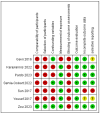Comparison of Early Enteral Nutrition Versus Early Parenteral Nutrition in Critically Ill Patients: A Systematic Review and Meta-Analysis
- PMID: 39796444
- PMCID: PMC11723109
- DOI: 10.3390/nu17010010
Comparison of Early Enteral Nutrition Versus Early Parenteral Nutrition in Critically Ill Patients: A Systematic Review and Meta-Analysis
Abstract
Background: Nutritional support is crucial in critically ill patients to enhance recovery, reduce infections, and improve outcomes. This meta-analysis compared early enteral nutrition (EEN) and early parenteral nutrition (EPN) to evaluate their efficacy in adult critically ill patients.
Methods: A systematic review of 14 studies involving 7618 patients was conducted, including randomized controlled trials, prospective cohorts, and retrospective analyses. The primary outcomes were mortality and infectious complications, while secondary outcomes included intensive care unit length of stay (ICU-LOS), hospital length of stay (H-LOS), mechanical ventilation days, and gastrointestinal (GI) complications.
Results: The results showed no significant difference in mortality between EEN and EPN (OR 1.03, 95% CI 0.93-1.14). EEN reduced bloodstream infections (OR 0.73, 95% CI 0.57-0.93), ICU-LOS (MD -0.18 days, 95% CI -0.33 to -0.04), and H-LOS (MD -1.15 days, 95% CI -1.38 to -0.93). However, EEN was associated with higher GI complications, such as vomiting and diarrhea (OR 2.25, 95% CI 1.97-2.58), while mechanical ventilation days showed no significant difference.
Conclusions: These findings support prioritizing EEN in critically ill patients with functional gastrointestinal systems to improve infection control and recovery while emphasizing the importance of careful monitoring to mitigate gastrointestinal complications.
Keywords: critical illness; enteral nutrition; meta-analysis; nutritional support; parenteral nutrition.
Conflict of interest statement
The authors declare no conflicts of interest.
Figures






References
-
- Singer P., Blaser A.R., Berger M.M., Calder P.C., Casaer M., Hiesmayr M., Mayer K., Montejo-Gonzalez J.C., Pichard C., Preiser J.C., et al. ESPEN practical and partially revised guideline: Clinical nutrition in the intensive care unit. Clin. Nutr. 2023;42:1671–1689. doi: 10.1016/j.clnu.2023.07.011. - DOI - PubMed
-
- McClave S.A., Taylor B.E., Martindale R.G., Warren M.M., Johnson D.R., Braunschweig C., McCarthy M.S., Davanos E., Rice T.W., Cresci G.A., et al. Guidelines for the Provision and Assessment of Nutrition Support Therapy in the Adult Critically Ill Patient: Society of Critical Care Medicine (SCCM) and American Society for Parenteral and Enteral Nutrition (A.S.P.E.N.) JPEN J. Parenter. Enter. Nutr. 2016;40:159–211. doi: 10.1177/0148607115621863. - DOI - PubMed
-
- Compher C., Bingham A.L., McCall M., Patel J., Rice T.W., Braunschweig C., McKeever L. Guidelines for the provision of nutrition support therapy in the adult critically ill patient: The American Society for Parenteral and Enteral Nutrition. JPEN J. Parenter. Enter. Nutr. 2022;46:12–41. doi: 10.1002/jpen.2267. - DOI - PubMed
-
- Elke G., van Zanten A.R., Lemieux M., McCall M., Jeejeebhoy K.N., Kott M., Jiang X., Day A.G., Heyland D.K. Enteral versus parenteral nutrition in critically ill patients: An updated systematic review and meta-analysis of randomized controlled trials. Crit. Care. 2016;20:117. doi: 10.1186/s13054-016-1298-1. - DOI - PMC - PubMed
Publication types
MeSH terms
LinkOut - more resources
Full Text Sources

